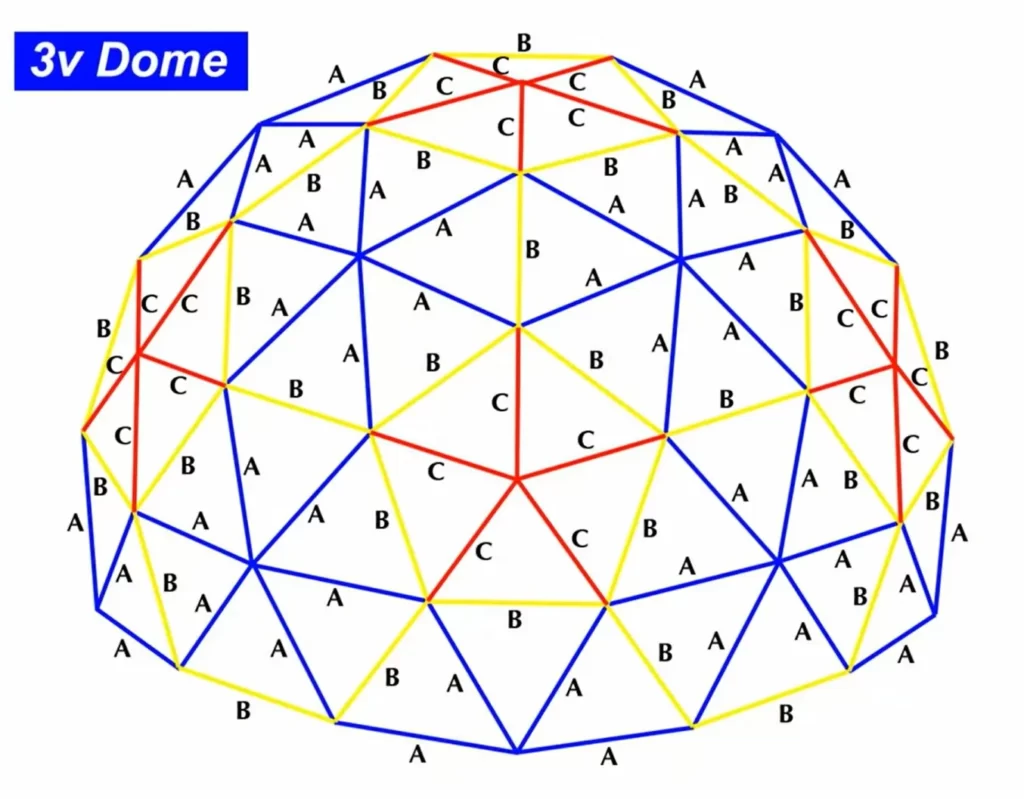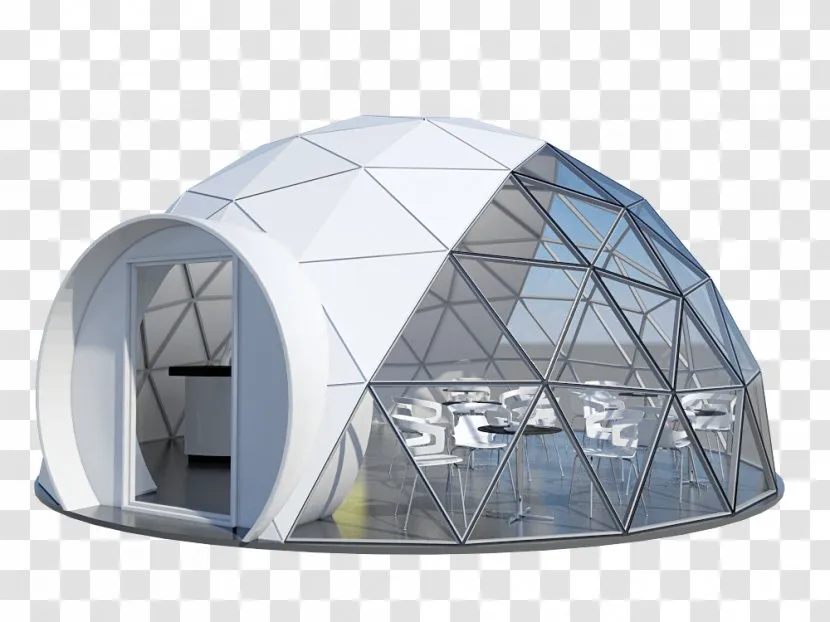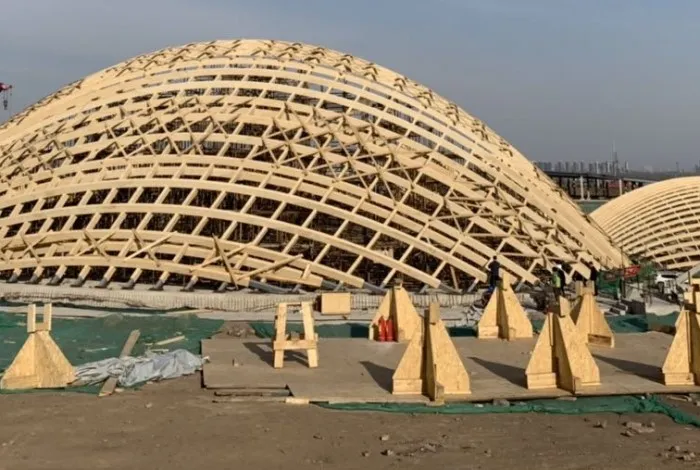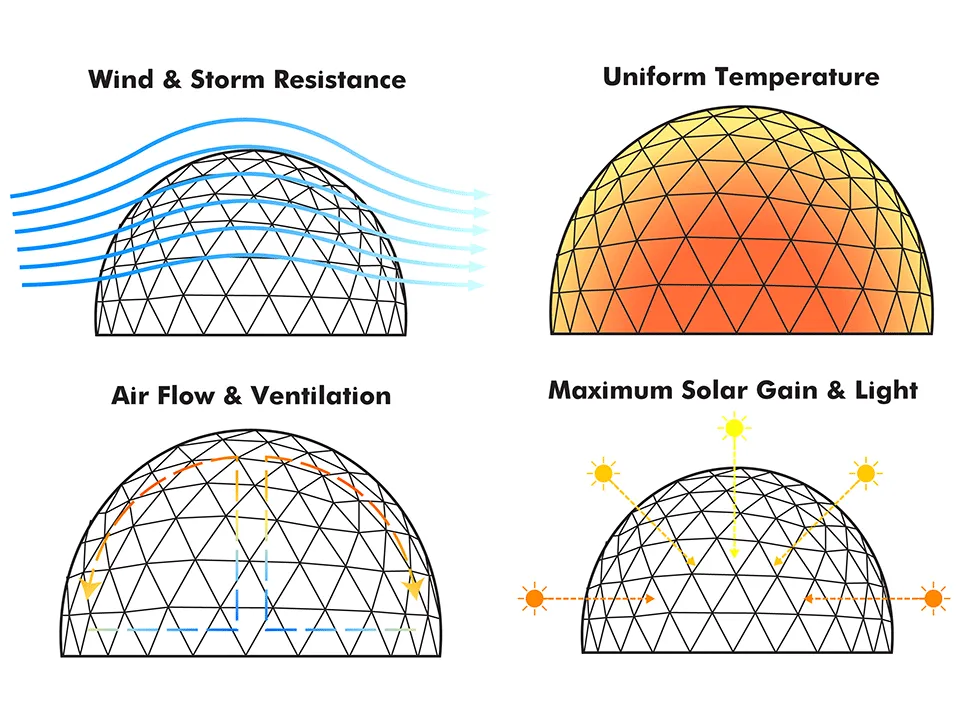A geodesic dome is a type of hemispherical structure composed of interconnected triangles that form a spherical or partially-spherical shell. The structure is based on the principles of geodesic geometry, which uses a network of great circles to create a curved surface that distributes stress and weight evenly.

If you want to know about the staircase design or landscape garden or requirements for disabled persons in a building, please click the link.
Historical background and origin of Geodesic Dome
The concept of geodesic geometry and its application in architecture was developed by the American architect and inventor, R. Buckminster Fuller in the mid-20th century.
He was inspired by the structural efficiency of natural forms, such as the hexagonal cells in honeycombs and the molecular structure of carbon atoms. In 1949, Fuller built his first geodesic dome using aluminum tubing and plastic sheeting, which he called the “Dymaxion Deployment Unit.”

The dome was lightweight, easy to assemble, and had a high strength-to-weight ratio, making it ideal for a variety of applications.
Importance of Geodesic Dome in Architecture
Geodesic domes have become an important architectural form due to their numerous benefits. These include:
- Strength and Durability: Geodesic domes are incredibly strong and can withstand extreme weather conditions such as hurricanes, tornadoes, and earthquakes.
- Versatility: Geodesic domes can be used for a wide range of applications, including residential, commercial, and industrial structures. They can also be used as greenhouses, exhibition spaces, and even as temporary shelters.
- Energy Efficiency: Due to their shape and construction, geodesic domes are highly energy-efficient. They require less heating and cooling compared to traditional buildings, resulting in lower energy bills.
- Sustainable Materials: Geodesic domes can be constructed using sustainable materials such as bamboo, timber, and recycled plastic, making them an eco-friendly option.
- Aesthetically Pleasing: Geodesic domes have a unique and futuristic appearance that makes them visually appealing. They can also be customized to fit specific design requirements and preferences.
Overall, the geodesic dome is an innovative and versatile architectural form that offers numerous benefits in terms of strength, durability, energy efficiency, and sustainability. It is no wonder that it has become increasingly popular in modern architecture.
1) The Mathematics behind Geodesic Dome
Explanation of Geodesic geometry and its principles
Geodesic geometry is a mathematical system that studies the shortest distance between two points on a curved surface, like a sphere. Geodesic domes are built using this geometry to create a spherical or partially-spherical shell made up of interconnected triangles.
The triangles are arranged to distribute stress and weight evenly across the structure, making it strong and stable. The principles of geodesic geometry include:
- Great Circles: Geodesic geometry is based on great circles, which are the largest possible circles that can be drawn on a sphere. These circles divide the sphere into equal halves, and all points on a great circle are equidistant from its endpoints.
- Triangulation: Geodesic domes are constructed by triangulating a spherical surface, which means dividing it into a network of interconnected triangles. Triangulation creates a strong and stable structure that can withstand stress and weight.
- Tensegrity: Tensegrity refers to the balance of tension and compression forces in a structure. Geodesic domes use this principle to create a self-supporting structure that does not require any internal supports.

Importance of mathematics in designing Geodesic Domes
Mathematics plays a crucial role in the design of geodesic domes. The complex geometry of the structure requires precise calculations to ensure that the triangles are the correct size and shape and that they are arranged in the correct pattern.
The calculations involve determining the angles and lengths of the triangles, the size and shape of the base, and the location and size of the openings. In addition, the mathematics is used to determine the strength and stability of the structure, as well as its load-bearing capacity.
Advantages of using Geodesic geometry in Architecture
The use of geodesic geometry in architecture offers numerous advantages, including:
- Structural Efficiency: Geodesic domes are incredibly strong and stable due to the use of triangulation and tensegrity principles. This makes them ideal for structures that need to withstand extreme weather conditions or heavy loads.
- Versatility: Geodesic domes can be used for a wide range of applications, from small backyard structures to large commercial buildings. They can also be customized to fit specific design requirements and preferences.
- Energy Efficiency: The shape of geodesic domes allows for efficient use of space and energy. The spherical shape reduces the amount of surface area exposed to external elements, which means less energy is required to heat or cool the interior. The structure also allows for natural ventilation and lighting, reducing the need for artificial systems.
- Sustainability: Geodesic domes can be constructed using sustainable materials such as bamboo, timber, or recycled materials. Their efficient use of materials and energy also contributes to their sustainability.
- Aesthetics: Geodesic domes have a unique and striking appearance that can enhance the visual appeal of a structure. They can also be designed to fit a variety of styles, from modern to traditional.
- Innovative Design: Geodesic domes offer architects and designers the opportunity to create innovative and unconventional structures that stand out from traditional building forms.
In summary, the use of geodesic geometry in architecture offers numerous advantages, including structural efficiency, versatility, energy efficiency, sustainability, aesthetics, and innovative design opportunities. Its use in construction continues to grow in popularity as architects and designers seek innovative and sustainable solutions to building challenges.
2) Structural Features of Geodesic Dome
Types of Geodesic Domes
There are various types of geodesic domes, each with unique features and applications. Some common types include:
- Frequency-based Domes: These domes are constructed based on a specific frequency, which refers to the number of triangles used in the structure. The most common frequencies are 2v, 3v, 4v, 5v, and 6v.





- Hemisphere Domes: Hemisphere domes are constructed as a complete or partial sphere. They are often used for outdoor structures like greenhouses, aviaries, and observatories.

- Tensegrity Domes: Tensegrity domes use a combination of tension and compression to create a self-supporting structure. They are often used for temporary structures like exhibition spaces and event tents.

- Gridshell Domes: Gridshell domes use a grid of wooden or metal beams to create a flexible shell structure. They are often used for large-span structures like sports arenas and concert halls.

Components of Geodesic Domes
Geodesic domes are made up of various components, including:
- Struts: Struts are the triangular pieces that make up the dome structure. They can be made of wood, metal, or plastic and are connected to form a network of triangles.
- Hubs: Hubs are the connectors that join the struts together at their vertices. They are usually made of metal or plastic and come in different shapes and sizes.
- Covering: The covering is the outer layer of the dome structure. It can be made of various materials like fabric, plastic, or glass.
- Foundation: The foundation is the base of the dome structure. It can be a concrete slab, wooden platform, or even the ground itself.
Advantages and Disadvantages of Geodesic Domes
Geodesic domes offer many advantages, including:
- Strength and Durability: The triangulated structure of geodesic domes makes them incredibly strong and able to withstand extreme weather conditions.
- Energy Efficiency: The spherical shape of geodesic domes provides natural ventilation and lighting, which reduces the need for artificial systems and saves energy.
- Versatility: Geodesic domes can be used for various applications, from small backyard structures to large commercial buildings.
- Cost-effective: Geodesic domes require fewer materials to construct than traditional buildings, which makes them a cost-effective option.
However, geodesic domes also have some disadvantages, including:
- Complex construction: The construction of geodesic domes requires a high level of technical expertise and can be challenging for inexperienced builders.
- Limited interior space: The curved walls of geodesic domes can make it difficult to maximize interior space, which can be a challenge for some applications.
- Covering maintenance: The covering of geodesic domes may require frequent maintenance and replacement depending on the material used.
In conclusion, geodesic domes offer numerous advantages and disadvantages. The choice to use a geodesic dome depends on factors like application, budget, and available expertise. However, as the need for sustainable and innovative building solutions grows, geodesic domes continue to be a popular choice for architects and designers.
3) Uses of Geodesic Dome in Architecture
Residential Applications
- Houses: Geodesic domes are increasingly being used as houses due to their energy efficiency, structural strength, and affordability. The dome shape allows for better insulation and natural light, while the triangulated structure makes them more resistant to strong winds and earthquakes.
- Greenhouses: Geodesic domes are also ideal for building greenhouses, as they offer a larger volume of space for growing plants and better control over temperature and humidity.
Commercial Applications
- Event Spaces: Geodesic domes are popular as event spaces due to their unique design and versatility. They can be used for weddings, concerts, and other outdoor events.
- Exhibition Spaces: Geodesic domes can also be used as exhibition spaces for trade shows and product launches. They offer a striking visual element that can help products stand out.
- Workspaces: Geodesic domes are also being used as workspaces, such as offices and studios. The unique design and ample natural light can help create a productive and inspiring environment.
Recreational Applications
- Camping: Geodesic domes are increasingly being used for camping and glamping due to their portability and ease of setup. They offer a unique camping experience and can be used in a range of outdoor environments.
- Play Spaces: Geodesic domes are also used as play spaces for children. They can be used as jungle gyms or playhouses and offer a fun and unique play experience.
- Zen Spaces: Geodesic domes can also be used as meditation or yoga spaces due to their calming atmosphere and ample natural light. They offer a unique environment for relaxation and reflection.
4) Famous Examples of Geodesic Dome in Architecture
The Dome of Montreal
The Dome of Montreal, also known as the Montreal Biosphere, is a geodesic dome located on Saint Helen’s Island in Montreal, Quebec, Canada. The dome was designed by the famous architect Buckminster Fuller and was built as the United States pavilion for the 1967 World Expo.

The dome is 76 meters in diameter and stands 62 meters tall. It is made up of 76 steel columns and 2,800 acrylic panels, which give it a striking appearance. The dome now serves as an environmental museum and is used for educational programs and events.
The Eden Project in Cornwall, UK
The Eden Project is a collection of geodesic domes located in Cornwall, UK. The project was designed by architect Nicholas Grimshaw and was opened to the public in 2001. The domes are used as a botanical garden and education center, and they are home to thousands of plant species from around the world.

The project consists of two large biomes, which are connected by a walkway. The first biome is the Rainforest Biome, which is the largest indoor rainforest in the world. The second biome is the Mediterranean Biome, which houses plants from the Mediterranean region. The domes are made up of hexagonal and pentagonal panels and are constructed from steel and ETFE, a lightweight, transparent material that allows natural light to filter through.
The Buckminster Fuller Dome in Carbondale, Illinois
The Buckminster Fuller Dome, also known as the Fuller Dome Home, is a geodesic dome located in Carbondale, Illinois, USA. It was designed and built by Buckminster Fuller in 1960 as a prototype for affordable housing.

The dome is 50 feet in diameter and is made up of a series of interlocking triangles. It was constructed using Fuller’s patented tensegrity design, which uses tension and compression to create a self-supporting structure. The dome now serves as a museum and educational center, showcasing Fuller’s life and work.
The Climatron in St. Louis, Missouri
The Climatron is a geodesic dome located in the Missouri Botanical Garden in St. Louis, Missouri, USA. It was designed by architect and engineer T. Y. Lin and opened to the public in 1960.

The dome is 70 feet in diameter and is made up of a series of interlocking triangles. It is constructed from aluminum and glass and houses a tropical rainforest ecosystem, complete with waterfalls and exotic plants. The dome is considered a masterpiece of modern engineering and architecture and is a popular tourist attraction.
The Aviary at the Cologne Zoo in Germany
The Aviary at the Cologne Zoo in Germany is a geodesic dome designed by architect and engineer Frei Otto. It was completed in 1971 and is considered one of the largest and most complex geodesic domes ever constructed.

The dome is 48 meters in diameter and is made up of a series of interlocking triangles. It is constructed from steel and glass and houses a variety of bird species from around the world. The dome is considered a masterpiece of modern engineering and architecture and is a popular attraction for visitors to the zoo.
5) Sustainability and Environmental Benefits of Geodesic Dome
Energy Efficiency
Geodesic domes are known for their energy efficiency. The shape of the dome allows for natural air circulation, which can help regulate indoor temperatures and reduce the need for heating and cooling. The compact shape of the dome also reduces the surface area of the structure, which means less energy is required to maintain a comfortable temperature. Additionally, geodesic domes can be designed to incorporate energy-efficient technologies, such as solar panels and rainwater collection systems.
Use of Sustainable Materials
Geodesic domes can be constructed using a variety of sustainable materials, including bamboo, recycled plastic, and salvaged wood. These materials are often more environmentally friendly than traditional construction materials, such as concrete and steel, which can have a significant impact on the environment. The use of sustainable materials can also reduce the carbon footprint of the construction process and increase the longevity of the structure.
Impact on the Environment
Geodesic domes have a relatively low impact on the environment compared to traditional construction methods. The use of sustainable materials and energy-efficient technologies can help reduce the carbon footprint of the structure. Additionally, the compact shape of the dome means less land is required for construction, which can help reduce the impact on natural habitats.

Geodesic domes can also be designed to be easily disassembled and recycled at the end of their life cycle, further reducing their impact on the environment. However, it should be noted that the impact on the environment will ultimately depend on the specific materials and construction methods used for each individual dome project.
6) Conclusion
Geodesic domes have revolutionized the field of architecture by introducing a new approach to design and construction. The use of geodesic geometry, mathematics, and tensional integrity principles has enabled the creation of strong, stable, and versatile structures that can be used for a wide range of applications. Geodesic domes offer numerous advantages, including energy efficiency, structural efficiency, and versatility, while also incorporating sustainable materials and technologies to minimize their impact on the environment.
The future of Geodesic Dome in Architecture
Geodesic domes are likely to continue to play a significant role in architecture in the future. As the world becomes more focused on sustainability and energy efficiency, the unique properties of geodesic domes make them an attractive option for a wide range of applications. Additionally, the use of computer-aided design software has made it easier to design and construct geodesic domes, making them more accessible to architects and builders.
As technology continues to advance, it is possible that new materials and construction methods will be developed that further improve the efficiency and sustainability of geodesic domes. Overall, the future of geodesic domes in architecture looks bright, and they will likely continue to be an innovative and versatile solution for a wide range of design challenges.
This is amazing! I grew up in a geodesic dome built on 4ft risers in Joshua Tree California. What an amazingly unique place to grow up 🩷